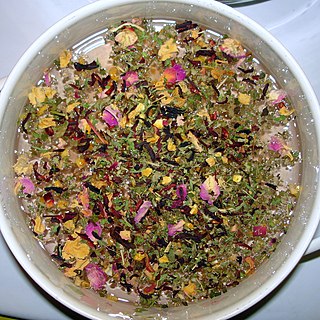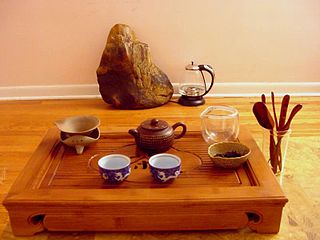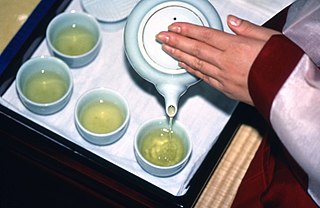
Bubble tea is a tea-based drink that originated in Taiwan in the early 1980s. Taiwanese immigrants brought it to the United States in the 1990s, initially in California through regions including Los Angeles County, but the drink has also spread to other countries where there is a large East Asian diaspora population.

In general, kung fu or kungfu refers to the Chinese martial arts also called quanfa. In China, it refers to any study, learning, or practice that requires patience, energy, and time to complete. In its original meaning, kung fu can refer to any discipline or skill achieved through hard work and practice, not necessarily martial arts. The literal equivalent of "Chinese martial art" in Mandarin would be 中國武術 zhōngguó wǔshù.

Oolong (, ; Chinese: 烏龍茶 is a traditional semi-oxidized Chinese tea produced through a process that includes withering the leaves under strong sun and allowing some oxidation to occur before curling and twisting. Most oolong teas, especially those of fine quality, involve unique tea plant cultivars that are exclusively used for particular varieties. The degree of oxidation, which is controlled by the length of time between picking and final drying, can range from 8% to 85% depending on the variety and production style. Oolong is especially popular in southeastern China and among ethnic Chinese in Southeast Asia, as is the Fujian preparation process known as the gongfu tea ceremony.

Tea is an aromatic beverage prepared by pouring hot or boiling water over cured or fresh leaves of Camellia sinensis, an evergreen shrub native to East Asia which probably originated in the borderlands of southwestern China and northern Myanmar. Tea is also made, but rarely, from the leaves of Camellia taliensis. After plain water, tea is the most widely consumed drink in the world. There are many different types of tea; some have a cooling, slightly bitter, and astringent flavour, while others have profiles that include sweet, nutty, floral, or grassy notes. Tea has a stimulating effect in humans, primarily due to its caffeine content.

Herbal teas, technically known as herbal infusions, and less commonly called tisanes, are beverages made from the infusion or decoction of herbs, spices, or other plant material in hot water. Often herb tea, or the plain term tea, is used as a reference to all sorts of herbal teas. Many herbs used in teas/tisanes are also used in herbal medicine and in folk medicine.

Taiwanese cuisine is a popular style of food with several variations, including Chinese and that of Taiwanese indigenous peoples, with the earliest cuisines known of being the indigenous ones. With over a hundred years of historical development, mainstream Taiwanese cuisine has been influenced by Hakka cuisine, the cuisines of the waishengren, Japanese cuisine, and American cuisine, with southern Fujian cuisine having had the most profound impact.

Tea ceremony is a ritualized practice of making and serving tea in East Asia practiced in the Sinosphere. The original term from China, literally translated as either "way of tea", "etiquette for tea or tea rite", or "art of tea" among the languages in the Sinosphere, is a cultural activity involving the ceremonial preparation and presentation of tea. Korean, Vietnamese and Japanese tea culture were inspired by the Chinese tea culture during ancient and medieval times, particularly after the successful transplant of the tea plant from Tang China to Korea, Vietnam and Japan by traveling Buddhist monks and scholars in 8th century and onwards.

Green tea is a type of tea that is made from Camellia sinensis leaves and buds that have not undergone the same withering and oxidation process which is used to make oolong teas and black teas. Green tea originated in China, and since then its production and manufacture has spread to other countries in East Asia.

Chinese tea culture includes all facets of tea found in Chinese culture throughout history. Physically, it consists of tea cultivation, brewing, serving, consumption, arts, and ceremonial aspects. Tea culture is an integral part of traditional Chinese material culture and spiritual culture. Tea culture emerged in the Tang dynasty, and flourished in the succeeding eras as a major cultural practice and as a major export good.

The culture of Taiwan is a blend of Han Chinese and indigenous Taiwanese cultures. Despite the overwhelming Chinese cultural influence and minority indigenous Taiwanese cultural influence, Japanese culture has significantly influenced Taiwanese culture as well. The common socio-political experience in Taiwan gradually developed into a sense of Taiwanese cultural identity and a feeling of Taiwanese cultural awareness, which has been widely debated domestically.

The Paiwan are an indigenous people of Taiwan. They speak the Paiwan language. In 2014, the Paiwan numbered 96,334. This was approximately 17.8% of Taiwan's total indigenous population, making them the second-largest indigenous group.

Hong Kong–style milk tea, also known as "silk-stocking" milk tea (絲襪奶茶), is a tea drink made from Ceylon black tea and evaporated milk. The drink originated in the mid-20th century during the British rule of Hong Kong, and was inspired by the British's afternoon tea.

Tea culture is how tea is made and consumed, how people interact with tea, and the aesthetics surrounding tea drinking.

Gongfu tea or kung fu tea, literally "making tea with skill", is a traditional Chinese tea preparation method sometimes called a "tea ceremony". It is probably based on the tea preparation approaches originating in Fujian and the Chaoshan area of eastern Guangdong. The practice involves using smaller brewing vessels and a higher leaf-to-water ratio than in Western-style brewing. Today, the approach is used popularly by teashops carrying tea of Chinese or Taiwanese origin, and by aficionados and trained masters as a way to fully realize the taste of a tea selection, especially a finer one.

Korean tea is a beverage consisting of boiled water infused with leaves, roots, flowers, fruits, grains, edible mushrooms, or seaweed. It may or may not contain tea leaves.

Agriculture is one of the main industries in Taiwan. It contributes to the food security, rural development and conservation of Taiwan. Around 24% of Taiwan's land is used for farming.

Taiwanese tea includes four main types: oolong tea, black tea, green tea and white tea. The earliest record of tea trees found in Taiwan is from 1717 in Shui Sha Lian (水沙連), present-day Yuchi and Puli, Nantou County. Some of the teas retain the island country's former name, Formosa.

Tatung Institute of Technology was an educational institution based in East District, Chiayi City, Taiwan. It had five new departments: Finance, Food and Beverage Management, Early Childhood Care and Education, Multimedia Design, and Leisure Recreation and Tourism Management, with a total of ten academic departments.

Dong Ding, also spelled Tung-ting, is an oolong tea from Taiwan. A translation of Dong Ding is "Frozen Summit" or "Icy Peak", and is the name of the mountain in Taiwan where the tea is cultivated. Those plants were brought to Taiwan from the Wuyi Mountains in China's Fujian Province about 150 years ago.
The artistic heritage of Taiwan is extremely diverse with multiple major influences and periods. Traditionally most arts were practiced for religious or ceremonial purposes. Art was first formalized under the Japanese but did not flourish until the democratic period. Art collecting has a long history in Taiwan and today Taiwan is one of the world's most significant art markets.



















